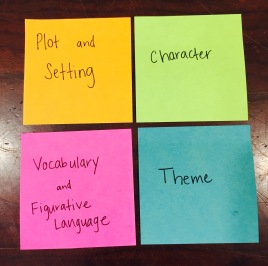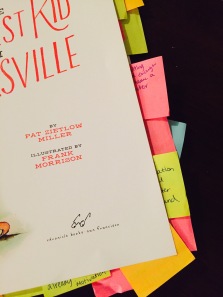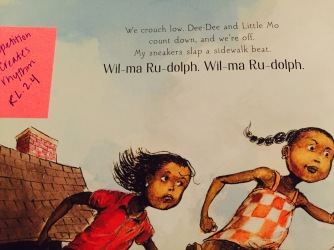I cannot believe that it is October and that I haven’t posted in a month! September seemed to fly by and took summer with it. Now that my television is teeming with political ads, I find myself wishing for the simple pleasures of August’s summer Olympics. Luckily, I have the perfect book to get my fix.
In the first of what I hope will be a regular feature, I plan to shine the spotlight on an individual book, highlighting different skills and standards to which the book lends itself particularly well.
Since this is the first post of its kind, I thought I’d start by telling you how I go about deciding what I might be able to use a book for. I bucket my thoughts into four categories, taken from Jennifer Serravallo’s Independent Reading Assessment and The Reading Strategies Book: plot and setting, character, vocabulary and figurative language, and themes and ideas. I give each category a different color sticky and I get going. I read the book four times through, each time through the lens of a different category and with a different color sticky in hand.
In the end, I have loads of ideas for how I might use the text, and the book ends up looking something like this:
So, onto the book spotlight! The Quickest Kid in Clarksville was written by Pat Zietlow Miller and illustrated by Frank Morrison. Alta is a girl growing up in Clarksville, Tennessee, which just happens to be the hometown of Olympic runner (and gold medalist), Wilma Rudolph. It’s 1960 and Clarksville is throwing a parade in celebration of Wilma’s gold medals. Alta knows she’s the quickest kid in town, just like Wilma, that is until Charmaine comes into the picture. She’s got fancy shoes and fast feet. Eventually, on the day of the parade, Alta, Charmaine, and their friends run the relay race of their lives to get a banner to the parade on time.
So, how could you use this book?
When I finished stickying up the book, I noticed just how many pink stickies I had (vocabulary and figurative language).
The book is just crying out to be used with standard RL.2.4: Describe how words and phrases (e.g., regular beats, alliteration, rhymes, repeated lines) supply rhythm and meaning in a story, poem, or song.
 The author repeats the name “Wil-ma Ru-dolph. Wil-ma Ru-dolph,” every time the characters are running, giving their feet a beat. She also repeatedly uses two word fragments across different pages to create a mood and a sense of rhythm (“Arms moving. Legs grooving,” and “Bodies lunge. Feet tangle,” and “Feet dragging. Head hanging.”) This isn’t the easiest standard to match texts to and this book was positively made for it.
The author repeats the name “Wil-ma Ru-dolph. Wil-ma Ru-dolph,” every time the characters are running, giving their feet a beat. She also repeatedly uses two word fragments across different pages to create a mood and a sense of rhythm (“Arms moving. Legs grooving,” and “Bodies lunge. Feet tangle,” and “Feet dragging. Head hanging.”) This isn’t the easiest standard to match texts to and this book was positively made for it.
How else could you use this book?
Plot and Setting
- Setting affects the plot: It matters that this story takes place in Clarksville in 1960.
- Multiple problems: Alta has the conflict with Charmaine about who is the fastest runner, she has the problem of not having new shoes and much money, and finally the problem of getting the banner to the race on time. Each of these ends up affecting what the character learns in the end.
- Passage of time: Midway through the story the line, “When parade day dawns…” tells the reader that it is now the next day.
- Identify the narrator: This story is told in the first person from Alta’s perspective. (This also makes it a great mentor for personal narrative!)
- Unassigned dialogue: At various points, readers need to use what is happening in the story to figure out who is speaking.
Character
- Infer character’s feeling: Much of what Alta is feeling must be inferred through what she says, thinks, or does, or through her facial expressions in the rich illustrations. There are opportunities for students to go beyond “happy” or “sad” to more rich feeling words.
- Character comparisons: Alta and Charmaine have more in common than they have differences. They don’t see their similarities, but skillful readers will.
- Feeling change: Alta’s feelings change about Charmaine and about herself throughout the story. Readers will have to identify when those feelings change, how they changed, and why they changed.
Vocabulary and Figurative Language
- Repetition and rhythm: As described above, this book is perfect for analyzing how and why authors use repetition of words, phrases, or even sentence structure.
- Simile: There are fantastic similes in this book! (“I puff up like a spitting cat,” “I leap after her like a scalded frog,” and so many more).
- Other figurative language: When describing her old sneakers, Alta laments that they have “laces that never thought to glimmer.”
Theme and Ideas
- Lesson revealed through an “Aha Moment”: Alta realizes that shiny shoes don’t matter as long as she has her feet. Readers will have to work to think about what this really means
- Character change reveals lesson: Alta changes her attitude towards Charmaine and in doing so gets the banner to the parade on time–also learning something about teamwork.
- Cross-genre work: Using Wilma Unlimited by Kathleen Krull, readers can work to compare the lessons learned from Wilma Rudolph’s real life to the lessons learned from this work of fiction.
I hope you enjoy this book as much as I did! Happy Reading!

Such a good idea! I did the same thing with Those Shoes, although not as organized! I just made it up and searched for strategies as I went. I like how you color coded the four strands.
LikeLike
Thank you! I love Those Shoes. Boelts’ new book will be my next spotlight, I think!
LikeLike
Very helpful post. I love the idea of creating the four buckets—I’m huge on color coding so I can see how I would use this idea. Thanks for sharing!
LikeLike
Thank you!
LikeLike